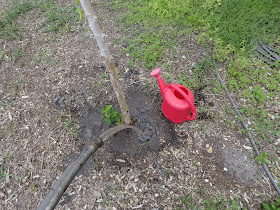I saw a
wonderful mass planting of dwarf snapdragons at a commercial site in Port
Charlotte the other day that really caught my eye and reemphasized my belief
that this often underutilized cold-hardy winter annual needs more
promotion. These cool season annuals have come a long way from their
native southern Mediterranean origins. Cold-tolerant and best grown in
our area in fall and winter, this colorful flower does well as a bedding plant,
in planters or a cut flower subject. Available in many heights and
colors, snapdragons love our winter weather.
Although
garden centers and nurseries presently have a large supply of snapdragons
ready-to-plant in your garden, they can be started from seed or even by
cuttings. Snapdragons do best in slightly acid soil in a full sun
site. Amending the soil with organic matter will help keep the soil
moist, but well-drained, as preferred by these plants. Water frequently
until the plants are established and then as needed. Set individual
plants about fourteen inches apart and place them in the soil at the same depth
they were in the pot as stem rots can develop if planted too deeply.
Pinching of young plants will force branching and subsequently more
flowers. Tall types of snapdragons may need to be staked to help support
the blooms. As a bonus, once the old flower heads fade, cut them back so
that only six nodes (a point where a leave attaches) remain and your
snapdragons will experience a second bloom. Fertilize at this point to
support this second blooming period.
Snapdragons
can be divided up into tall types which grow to about two to three feet tall,
intermediate sizes from one to two feet tall, bedding types that fit into the
six to fifteen inch range and rock garden varieties that grow only about six
inches tall. The tall types include cultivars such as 'Rocket',
'Burpee's Topper', 'Spring Giant', 'Bright Butterflies', and 'Panorama'.
These snapdragons not only look good in the garden, but also make great cut
flowers in bouquets. For intermediate snapdragons, you might find
'Liberty', 'Monarch', 'Pixie', 'White Wonder', 'Black Prince' and 'Vanity
Fair'. You may also be able find some of the popular dwarf
cultivars such as 'Tahiti', 'Tom Thumb', 'Floral Carpet', 'Magic Carpet',
'Little Gem' and a bi-colored variety called 'Peaches and Cream'. As a
general rule-of-thumb, snapdragons with dark colored flowers have dark green or
reddish stems and those with white or pale flowers have pale green stems.
Snapdragons
do fine by themselves, but also make great companions for plants such as
pansies. Add some of these colorful and winter-hardy flowers in your
landscape beds today! For more information on all types of annual
flowers, please call our Master Gardener volunteers
on the Plant Lifeline on Mondays, Wednesdays and Fridays from 1 to 4 pm at
764-4340 for gardening help and insight into their role as an Extension
volunteer. Don't forget to visit our other County Plant Clinics in the
area. Please check this link for a complete list of site locations, dates
and times - http://charlotte.ifas.ufl.edu/horticulture/Plant%20Clinics%20Schedule.pdf
.
Resources:
Gilman,
E. F. (2014) Antirrhinum majus Snapdragon. The University of
Florida Extension Service, IFAS.
Gilman,
E. F. (2014) Antirrhinum majus 'Tahiti', Tahiti Snapdragon. The
University of Florida Extension Service, IFAS.
Gilman,
E. F. (2014) Antirrhinum majus 'Liberty', Liberty Snapdragon. The
University of Florida Extension Service, IFAS.
Christman,
S. (2004) Antirrhinum majus . Floridata.com
Klingaman,
G. (2004) Plant of the Week: Snapdragon. The University of Arkansas.
Winter,
N. (2002) Southern Gardening - Snapdragons Make Ideal Fall Plantings.
Mississippi State University.








